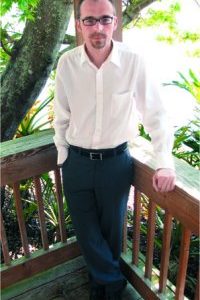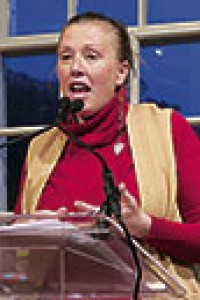Spotlight on: Kelley Armstrong, Writer
Kelley Armstrong has been telling stories since before she could write. Her earliest written efforts were disastrous. If asked for a story about girls and dolls, hers would invariably feature undead girls and evil dolls, much to her teachers’ dismay. All efforts to make her produce ‘‘normal’’ stories failed. Today, she continues to spin tales of ghosts and demons and werewolves in her Women of the Otherworld and Darkest Powers young-adult urban fantasy series.
When I created the young-adult series, I knew I wanted at least some of the supernatural types that I used in the Otherworld, so it made the most sense just to re-use the universe. Otherwise, it wouldn’t have been long before I started confusing my elements of world-building! The downside is that I’m doing two books in the same world every year and I’d really like more variety and breadth, which is one reason I’ve decided to stick to my original plan of ending the Otherworld next year (with book 13).
Your Darkest Powers series is for teens, while the Otherworld series is meant for adults. How does your process or approach differ in writing for those two audiences?
It differs a lot less than I expected. When I had an idea for a YA series, I thought it would be much different than writing for adults. Then I read modern YA and realized the plots and characters are just as complex. Yet writing teenage characters is different – they have very different skill sets, issues, and concerns, which must be reflected in the story. It can’t be about so-called 16-year-olds who act and think like 26-year-olds. That’s the toughest part – getting back into the mindset of a teen. Luckily, I had a captive subject – a teenage daughter – to study.
Much urban fantasy is concerned with strong (even kick-ass!) female heroines, and yours is no exception – but you also wrote Men of the Otherworld. What’s the role of male characters in urban fantasy – and what should it be?
I don’t think there’s a set role for male characters in urban fantasy. They can be friends, mentors, villains, foils – the same as female characters. If they’re going to be lovers, though, they need to be as strong and as well written as the protagonist. I see the male lead as an equal partner to the female lead. He helps her and challenges her and makes her a better, stronger person. There can be a temptation to underwrite the male characters, to allow the women to seem stronger and more vibrant in comparison, but that’s a cheat and, worse, implies that women need that contrast with weak men in order to appear strong.
Tell us about your new trilogy The Blackwell Pages, co-written with Melissa Marr. Why move into middle grade fiction? What are the benefits (or drawbacks) of collaborating with another writer?
The Blackwell Pages is about three 12-year-olds growing up in a South Dakota town run by the distant descendants of Thor, who use their authority to control the other inhabitants – descendants of Loki. When signs of Ragnarok begin, the kids realize they’ll need to play their roles in the old Norse myths to stop it. I started writing YA in part for my teenage daughter. Melissa writes YA and also has a teen daughter and we connected through that – our daughters were reading the other’s books. We also have pre-adolescent sons (she has one and I have two). So now, having written for our girls, we want to do the same for our boys. And it gives us an excuse to play in the world of Norse mythology, which we both love. It’s still too early in the process to know all the benefits and drawbacks. Fortunately, we’ve worked together on other projects – arranging group tours and writing retreats, co-editing anthologies – so we knew we can work together. The biggest benefit so far has been having an equally invested ‘‘critique partner,’’ both for brainstorming and editing. Also, it challenges me to do my best, knowing that a writer I admire will ultimately share any responsibility – and criticism – for the sections I write.
What’s the attraction of writing supernatural fantasy instead of, say, crime novels or ‘‘literary’’ fiction or romance?
As a Canadian, I grew up in a culture with a strong emphasis on literary fiction. We’re very proud of our ‘‘Can-Lit’’ superstars. But I don’t write literary fiction. It’s not my style or my area of interest. I love genre fiction – all genres, which makes supernatural fantasy the perfect choice for me. I can take elements of horror, mystery, romance, and fantasy, and put them all in one story. The only thing I’m missing is Westerns. When asked what I want to do that I haven’t done, I always say ‘‘a werewolf Western.’’ People usually think I’m joking. Sadly, I’m not.
For your new series (Waking the Witch, Spell Bound) you ‘‘grew up’’ a youngadult character to anchor a spinoff series. Why did you decide to follow an existing character into adulthood instead of creating a new protagonist?
I introduced Savannah in book 2 (Stolen) when she was 12. My plan was to have her grow up through the series, weaving through the lives of all the characters and ultimately taking the reins in a big seriesending trilogy. It seems fitting that, in a series about supernatural women, we’ve watched this one character grow from girl to young woman, and now we’ll end it seeing her take those last steps into maturity and joining the other protagonists as a ‘‘woman of the otherworld.’’







Pingback:The Great Geek Manual » Geek Media Round-Up: July 29, 2011
Pingback:July 29, 2011 Links and Plugs : Hobbies and Rides
Pingback:Cora Buhlert
Pingback:Geek Media Round-Up: August 1, 2011 – Grasping for the Wind